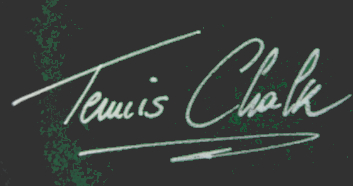Moving From One-Night Stands To Week-Long Pro Tournaments
Having written about the game for ages, story ideas have come to me in a variety of ways. Some were assigned by publication editors. Then there were topics that I thought would provide an interesting read if approached from a “different” angle, so I “pitched” them to outlets. A few… “just appeared” thanks to something I witnessed or had been told. These were ideas that left me thinking, “Now, there’s a story I would like to tell… and better yet, it would be a fun write…”
In January 2022, I received an email from Tom O’Neal wishing me a Happy New Year and adding, “…I trust you are still writing about tennis. Please give me a call at your convenience as I had a thought that might be of interest to you…”
And that was how this “fun to write” came about…belatedly.
O’Neal is a special friend primarily because he is, if it is possible, “More Than…” a Renaissance Man when it comes to his approach to life and to tennis. He has traveled widely and has a diverse corporate executive background. He has also worked at every level of the game which has given him an appreciation of what has taken place and more important all that was required to see a project to fruition. Before I go too much further, I should add, when I told him I was writing this feature and asked how he would like to be identified, he said, “Just say I am a retired business executive and a volunteer tennis activist.” (There is more about O’Neal in the “St. Louis Tennis Backstory”.)
After our telephone visit, he emailed saying, “As I mentioned, I thought the signal advancement of pro tennis in the 1960’s was moving from the one-night stands format in numerous cities to a series of weeklong tournaments. Butch Buchholz explained to me that when he was playing and working with Jack Kramer for the pro tour it was decided in the early 1960’s to try a series of five or six weeklong tournaments, like the golfers had in those days. I recall he mentioned that signing Rod Laver to the group was a key. Butch managed to get a sponsorship commitment, the first, from a St. Louis Volkswagen dealer, George Capps. They leveraged this sponsorship to secure five or six more and the tour was born, I think in 1963.” (Actually, it was 1964.)
***
In “The Bud Collins History Of Tennis: An Authoritative Encyclopedia And Record Book”, the late 1994 International Tennis Hall of Fame inductee (and a dear friend) said of 1964 and the birth of week-long pro tournaments, “…Jack Kramer was enlisted to contact the far-flung gypsies and put together, with the help of Butch Buchholz, a short summer circuit with about $80,000 in total prize money…”
***
In the late 1950s, Buchholz was one of the best juniors in the world. He was the Boys’ Singles titlist at Roland Garros and The Championships in 1958. The same year, he doubled at the United States Lawn Tennis Association National Boys’18 Championships winning the singles and the doubles with fellow St. Louisan, Chuck McKinley. In 1959, he was the Australian Junior Boys’ Singles and Doubles champion with José Luis Arilla of Spain.
(Since the US Open Junior Singles competition didn’t begin until 1973, Buchholz was a Grand Slam Junior Champion holding all three of the major titles at once. In February 1959, he appeared as a mystery contestant on the television quiz show “To Tell the Truth” and said he was a Grand Slam Junior Champion.)
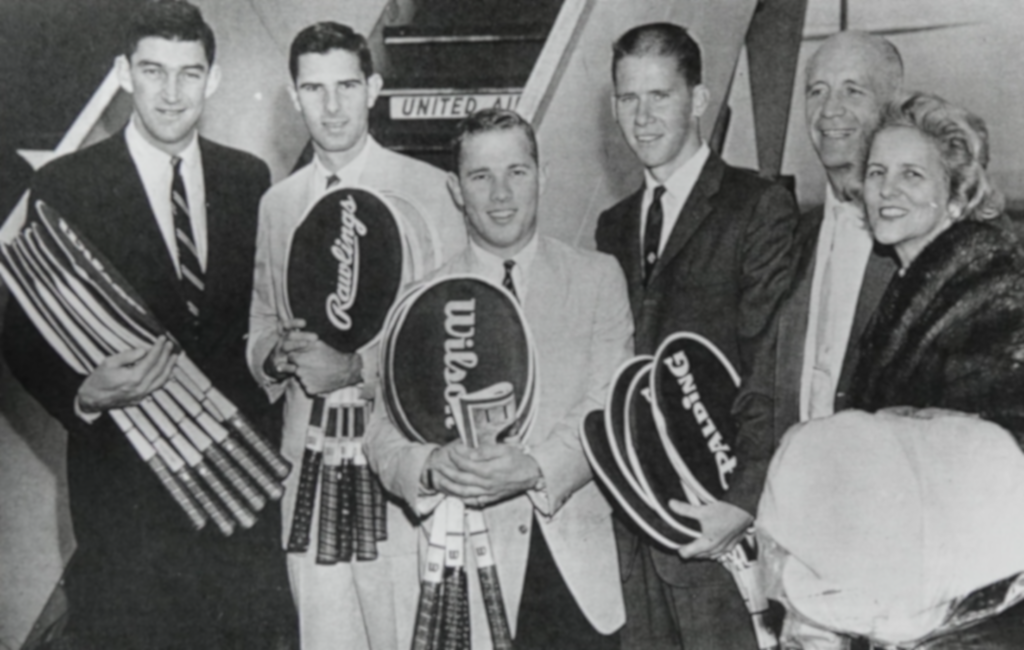
1960 US Davis Cup captain, David Freed and his wife, Blanche.
Photo St. Louis Tennis Hall of Fame
He was ranked in the US Top 10, four times; esteemed British tennis journalist Lance Tingay rated Buchholz the World’s No. 5 amateur in 1960. He was a member of the US Davis Cup team in 1959 and ’60, the same year he lost to Laver in the semifinals of the US National Men’s Singles championship. In 1961, he turned pro and joined the Jack Kramer Tour. In 1968, he became an original member of Lamar Hunt’s “Handsome Eight” part of the inaugural World Championship Tennis (WCT) circuit.
***
Speaking with me from his home in Ponte Vedra Beach, Florida, he expanded O’Neal’s account about the week-long event…The St. Louis Bi-Centennial Professional Tennis, $15,000 Tournament played at the Triple “A” Club, June 29-July 4, June 1964. (The tournament has also been titled the St. Louis Bicentennial. As it turned out, the prize money was $10,000 and it was played June 7-13. Even more interesting, a Bi-Centennial poster listed ticket prices for Adults as $3.00 for weekday; $4.50 for the weekend; and $15.00 for a Tournament Pass [$144.00 in 2023] Children paid $1.75 for weekday; $2.25 for weekend; and $10.00 for a Tournament Pass [$96.00 in 2023].)
“We were playing one-night stands,” Buchholz said of professional tennis at the time. “There were only a few tournaments ((See below…). Golf was taking off in the early 1960s and we thought we should change what we were doing. We had sixteen to twenty guys, who had won major tournaments, but everyone thought we were playing exhibitions. Actually, we played for a percentage of the gate so the more you won the more you could make…”
***
(In those days, the pro tournaments included The Indoor Professional Championship played at Wembley in London. The French Professional Championship [“Championnat International de France Professionnel”] took place at Roland Garros in Paris. The Pro Championship was held in variety of US cities.)
***
The week-long idea went from discussion to actuality because Kramer had friends in Boston and living in Los Angeles, the Los Angeles Tennis Club was his “home…”, meaning a site receptive to holding a tournament; Barry MacKay had a contact at Peacock Gap in San Rafael, California; and Buchholz was from St. Louis…all locations for staging initial tournaments.
Buchholz continued “…We wanted to see if we could find some sponsors and see if we could find some sites and play some tournaments which we did… By 1967 we had 20 to 25 tournaments around the world.”
Regarding St. Louis he remembered, “George Capps was a Volkswagen distributor and had dealerships in the area. He had a big family, and they were all into tennis. He became a sponsor and so did Anheuser-Busch and First National Bank. It was fun for me…It was my first experience, my introduction to not just playing but setting up sponsorships and selling box seats… running the event…It was a very good involvement.
“One of the Volkswagen guys said we should set up a court on a street downtown and have an exhibition. I thought it would be neat to have people hanging out of department store windows watching. Charlton Heston and Jimmy (James) Franciscus came in and everyone wanted to see them. They played with Rod (Laver) and I… It got great media coverage.”
***
Finding newspaper articles about a tournament that took place 59 years ago would ordinarily require a lengthy microfilm search… Fortunately, Katie Harnett, the Research & Education Manager at the International Tennis Hall of Fame in Newport, Rhode Island, came to the story’s rescue. She discovered that Harold Flachsbart wrote about the tournament for the St. Louis Post-Dispatch.
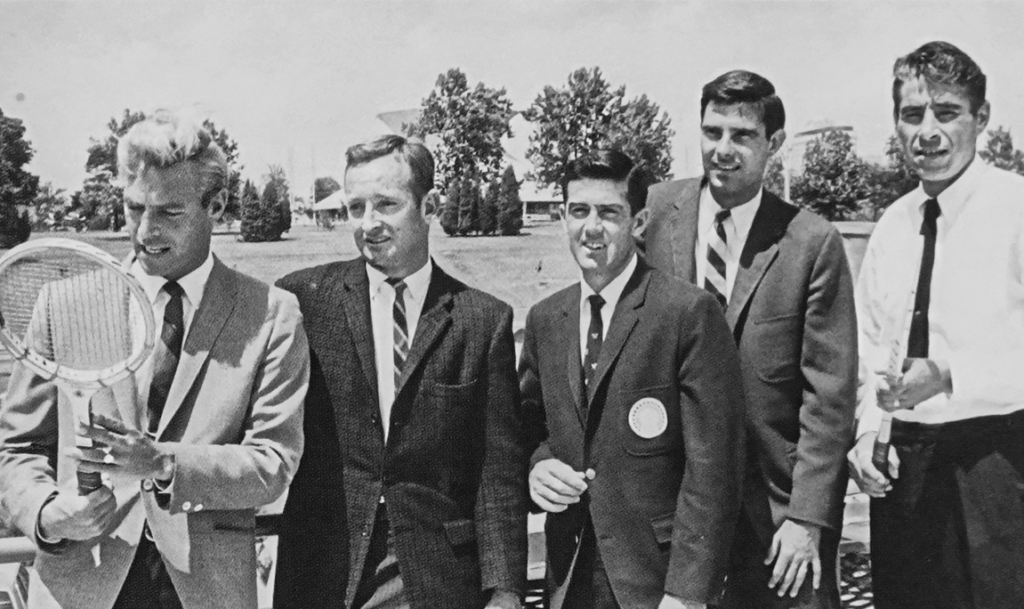
Photo St. Louis Tennis Hall of Fame
Here is a collection of his impressions that provide a feel for what the infancy of a week-long men’s professional tournament was like … It is a primer on the first staggering steps that led to the development of an industry that today makes almost $150 million annually.
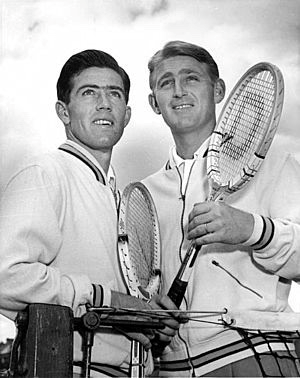
Photo Australian Davis Cup
“Tennis Pros Play Here Tuesday” … Flachsbart detailed on June 7, 1964…
“…There has been street dancing in St. Louis but never before a tennis match on a downtown street.
“As part of the buildup for the Bicentennial professional tournament at Triple A… famed pros will play Wednesday noon on Eight Street between Olive and Locust.
“… The match is to be held under the auspices of Downtown St. Louis, Inc. and the Visitors’ Center at the old Post Office building.”
He pointed out, “… This is the first year in which the professionals have scheduled week-long summer tournaments … on the order of the golf tour… instead of one-night stands in various cities…”
In his narrative he said that with ten of the world’s top pros participating, Ken Rosewall, the 5’7” “Mighty Mite”, and the glowering 6’3” Richard “Pancho” González were the favorites.
Flachsbart added, “Besides (Ken) Rosewall and (Lew) Hoad two other Australians in the field are Rod Laver and Frank Sedgman, both former Davis Cup heroes.
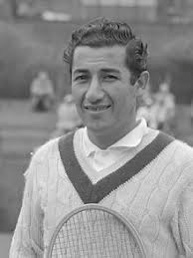
“Andrés Gimeno (El Matador) of Spain… Luis Ayala of Chile, Alex Olmedo of Peru, Earl (Butch) Buchholz of St. Louis and Barry MacKay of Cincinnati are the other members of the ‘Big Ten’. Anyone on a hot streak is capable of winning the top prize. Two teaching pros from this area, Dick Horwitz, and Larry Miller, complete the Triple A field.”
***

“Buchholz Was Never Better His Opening Victim Says…” on June 10th Flachsbart offered…
“…Luis Ayala of Santiago, Chile a pro for four years, said after his 6-1, 6-2 defeat, “I’ve never seen Butch play better.
“…Another St. Louisan could take a bow…Dick Horwitz, former Washington University captain and coach, made an impressive showing despite a 7-5, 6-3 defeat (to Sedgman). The teaching pro at Bellerive gave Sedgman all he could handle in a sizzling first set then wilted in the humid heat in the second set.
“Sedgman felt, ‘He played a fine game…’”.
Olmedo, during his first set loss against Mike Davies of Great Britain, who replaced the injured MacKay, lamented the ball bounces he was getting off the Har-Tru. González, a spectator, chided, “Quit crying, Chief (Olmedo’s nickname).”
Following his, 3-6, 6-2, 6-2 victory, the Peruvian said, “You have to get used to the court…”
***
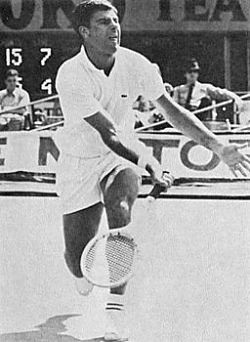
Photo This Week in Sport & Leisure History
When I discussed the teaching pros that participated in the tournament, Buchholz said, “I knew Dick (Horwitz) and Larry (Miller) very well. We played in the juniors; we basically grew up together and spent time at the Armory. Later, Larry ran it; he was the pro. When people started to build indoor tennis clubs, there were probably seven or eight other than the Armory, Larry and I built the Town & Tennis Club…” (Larry and Dick won the 1963 Midwest Open Pro doubles.)
O’Neal remembered, “I used to play at the Town & Tennis Club. It was in a warehouse building in Dielman Industrial Court in Olivette, Missouri. Butch and Larry (Miller) started it…Probably, as did other indoor tennis clubs in the area, in the late 1960s when all the baby boomers were turning 20. It peaked in 1974 when BJK (Billie Jean King) beat (Bobby) Riggs, and then declined as the boomers turned 40 and women started to work. I recall there were four indoor courts and locker rooms plus office space. One wall had a mini-Hall of Fame that had a photo/plaque of Rod Laver, noting he was the first player to earn $1M, and one of Butch saying he had been No. 5 in the world. I think there were about six or eight photos on display. I recall the real estate person involved was Solon Gershman, who was an investment banker with his own mortgage and commercial real estate company. Butch told me he gave Solon tennis lessons in exchange for Solon giving him lessons about business, finance and accounting as Butch was only a GED high school grad. They later sold the club, and it closed some years ago.”
***
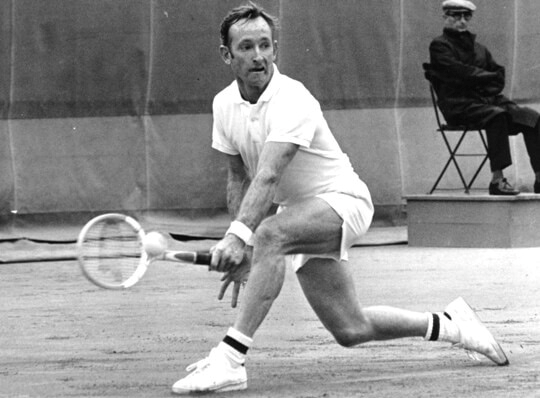
“Buchholz Defeats Laver” …gave Flachsbart an opportunity, on June 12th, to discuss what was taking place behind the scenes…Such as González, weary after defeating Hoad, 6-4, 6-3, turning to Ayala in the Triple A locker room and say, “Abuelitos” (broadly translated-Little old grandfathers).
He said of the “up and down” match, “…You can’t go all out on every point in this kind of heat…You have to take a little and give a little…I thought the linesmen made several questionable calls…but I guess I had the breaks on two out of three…”
(Given the level of professionalism found in umpiring today, it is amazing that, as Buchholz remembered in the early days of the tour, “We used to pull people out of stands to call lines…”)
Playing when the temperature was the highest, Buchholz escaped with a 6-4, 7-9, 6-4 victory over Laver. “…I knew the heat was bothering him just as much as it bothered me. He put ice water on a neckerchief between court changes…
“I would like to win here… more than any place else…”
Having played with an ankle problem Buchholz revealed, “I tried to apply the ‘extra something’ in the match with Laver and I guess it helped.”
***
It is happenstance but it must be noted that below Flachsbart’s account of the day’s play was a UPI article titled, “Trabert Speaks Out For Open Tennis”. The former US tennis star, who was the Executive Director of the International Professional Tennis Players’ Association formed in 1963, said while doing two-days of junior clinics in Salt Lake City, Utah, “I think it will eventually come but it will take some doing…but it will take almost complete agreement before the amateurs and professionals play one another.”
In his book, Collins said “…Off the court, the entire troupe (the Kramer pros) hoped dearly that the International Lawn Tennis Federation (ILTF) would at last approve Open Tennis. A painfully close moment came in 1960, when a motion to make that happen failed by five votes…”
The pros were under contract, but Kramer believed for progress to be made (meaning Open Tennis), the professionals had to have a separate organization which led to the creation of the International Professional Tennis Players’ Association (IPTPA which has also been referred to as the Independent Tennis Players’ Association) in early 1963. Tony Trabert was the Executive Director and Buchholz, along with Mike Davies and Barry MacKay, played significant roles in the organization’s early development.
***
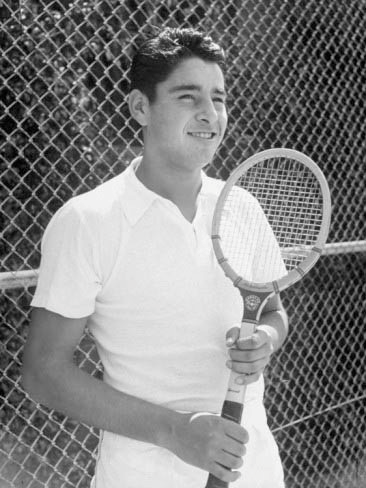
Photo Comic Book Religion
“González, Rosewall Reach Pro Net Final” … Flachsbart detailed on June 14th how rain forced some of the play to take place indoors “on the boards” (the basketball court) at the Washington University field house…where Rosewall defeated Buchholz, 6-2, 7-9, 6-3. In a match pairing 36-year-olds González defeated Sedgman, 6-4, 6-3.
In the doubles semifinals, Olmedo and Gimeno downed Laver and Ayala, 11-9, 11-9 and Davies teamed with Rosewall to slip past González and Sedgman, 10-8, 10-8.
***
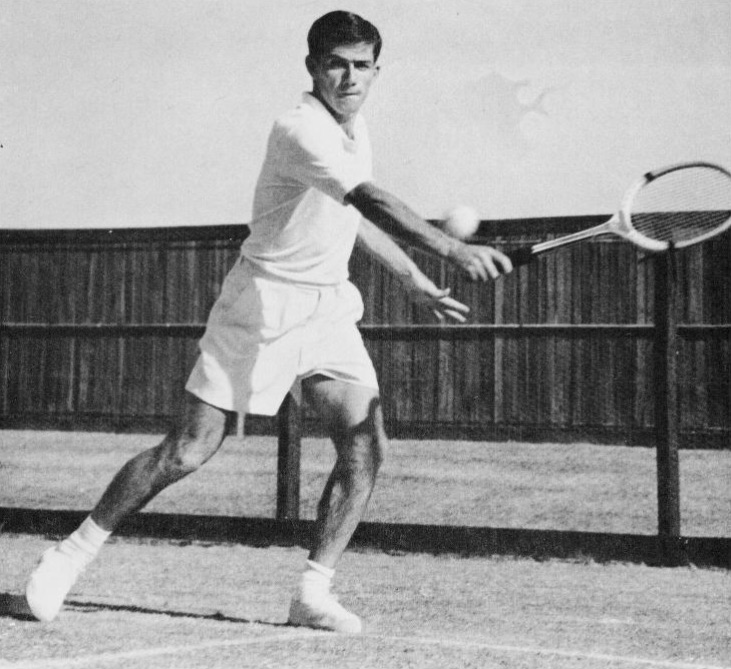
In his first Bicentennial story Flachsbart showed his prognostic skill predicting that the 5’7” “Mighty Mite” Rosewall, and the glowering 6’3” González were the favorites…and he proved to be “Spot On…” In his final tournament report, “Rosewall Proves Best Of Consistent Aussies” … He stated, “…Rosewall, who sparkled on a sizzling day pounced on Pancho González of Los Angles, former pro king, for a 6-4, 6-3 victory in the singles final that netted him a big trophy and a not-so-slim check for $1750.00 (Today, depending on calculating system used, a little more than $17, 300.)
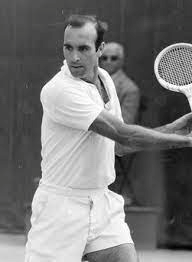
Photo International Tennis Hall of Fame, Newport, Rhode Island
“…Alex Olmedo of Peru and Andrés Gimeno won the doubles final over Davies and Rosewall, 2-6, 6-3, 6-3.”
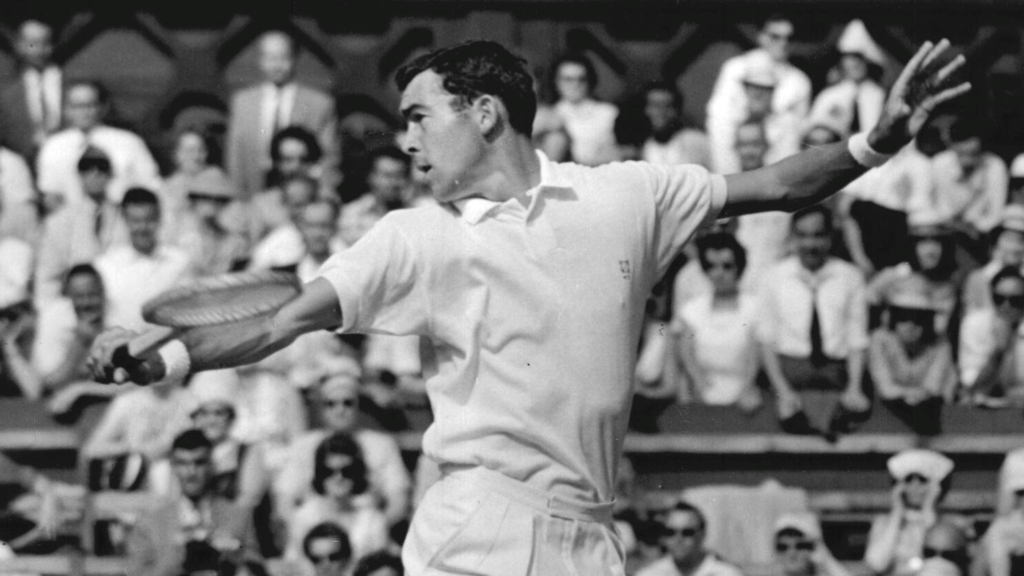
Based on Flachsbart’s figuring, González collected $1,200; the doubles winners split $600 and the doubles finalists $400.
Rosewall, after saying that he had no special strategy in the final, pointed out, “On a humid, hot day such as this, the ball seems to rise higher after a powerful serve, and it seemed to help me in returns…”
González said, “… Rosewall was on the beam and played well. I didn’t”
Buchholz lost the third-place playoff, 6-3, 2-6, 6-3 to Sedgman.
Rosewall concluded, “I think this St. Louis tournament was one of the best on our circuit. I’m anxious to come back next year. We have three more steps on this summer circuit…then we go to Europe.”
***
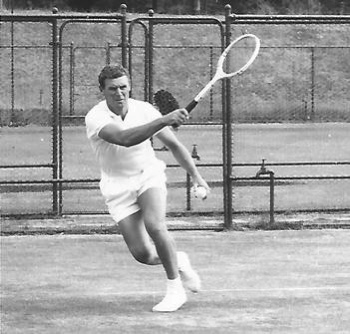
Prior to the tournament in “Sedgman Says Pro Tennis Will Reach New Heights”, the President of the IPTPA told Flachsbart that though the new professional tournament format had started slowly…
“We must gain a little momentum…” Still, He was positive about what was ahead. “We didn’t draw too many people in Maryland, but we know we’ll do well in Los Angeles. That’s a good tennis center and Pancho González will be a drawing card. Pancho will be an attraction in St. Louis, too…”
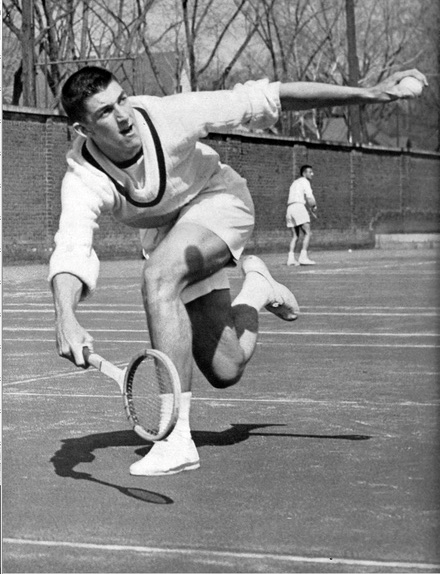
In a Guam Daily News feature on June 17th titled, “Pros Fight to Survive In Net Competition”, MacKay, IPTPA Vice President who attended the tournament, expressed frustration saying, “It’s hard to figure but all over the world the sports public is being fooled. Any match in one of our tournaments would be better than an amateur match in the world.”
***
As a player and later as an administrator, the personable Buchholz had an innate feel for shots and situations. He told me, “Jack (Kramer) had great vision and part of the reason it took so long for Open Tennis to come about was because of the fear the ILTF and particularly Australia had that he would take over…I thought professional tennis was a sure thing, so I turned pro at 20 (in 1961). I figured by the time I was 23, I would be ready because of the experience I had gained…”
Buchholz and MacKay joined the other “One Night Stand” travelers that included Hoad, Sedgman, Olmedo, Gimeno, along with Aussies, Ashley Cooper, and Mal Anderson.
In a story, Buchholz once said that his professional tennis resume included playing 29 matches in 31 days in 30 cities…. “I became a pro young, figuring I’d get a jump on Open Tennis…But then it didn’t happen. It was frustrating…”
Little did he realize that those controlling the game would treat the idea like the albatross in “The Rime of the Ancient Mariner” and force the professionals to be neck tied for another seven years.
***
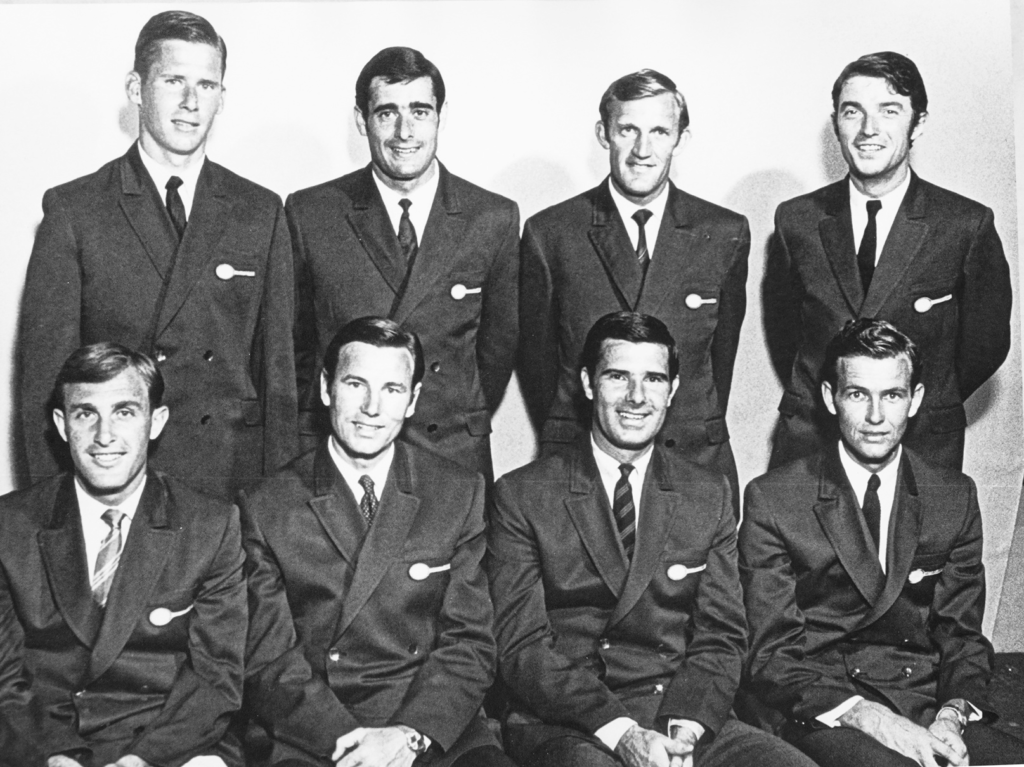
Dennis Ralston, Roger Taylor, Tony Roche and Pierre Barthès-Back Row
John Newcombe, Nikola “Niki” Pilić, Buchholz and Cliff Drysdale-Front Row
Photo St. Louis Tennis Hall of Fame
Buchholz’s professional career was shortened by nagging injuries…He played the tour from the age of 19 until he was 29 and was a member of Lamar Hunt’s celebrated World Championship Tennis’ “Handsome Eight” …and would go on to directed WCT tournaments from 1969 until ‘78. He continued to expand his involvements in the game. The St. Louis tournament, which he directed from 1964 until ’68, provided an initiation and his friendship with Solon Gershman, founder of a prosperous real estate and investment firm, resulted a “Harvard education without having to attend college…” (As mentioned, they traded tennis lessons for business lessons.)
His early administrative activity included Commissioner of World TeamTennis 1977-1978; Executive Director of the ATP 1981-1982 (He led the development of the players’ pension fund); member of the Men’s Pro Council 1981-1983.
In 1985, with his brother Cliff, he founded The Lipton International Players Championships which in its third year became a spring tennis institution in Key Biscayne, Florida (now known as the Miami Open). Asked about the impact he has had, Buchholz graciously offered, “I am proud of St. Louis because it was the beginning of a change…I am also proud that Cliff and I started the first tournament outside of the Grand Slams that had men and women playing at the same time…”
